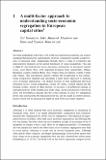Files in this item
A multi-factor approach to understanding socio-economic segregation in European capital cities
Item metadata
| dc.contributor.author | Tammaru, Tiit | |
| dc.contributor.author | Musterd, Sako | |
| dc.contributor.author | van Ham, Maarten | |
| dc.contributor.author | Marcińczak, Szymon | |
| dc.contributor.editor | Tammaru, Tiit | |
| dc.contributor.editor | Marcińczak, Szymon | |
| dc.contributor.editor | van Ham, Maarten | |
| dc.contributor.editor | Musterd, Sako | |
| dc.date.accessioned | 2015-08-26T09:10:02Z | |
| dc.date.available | 2015-08-26T09:10:02Z | |
| dc.date.issued | 2015-08-12 | |
| dc.identifier | 212243068 | |
| dc.identifier | 0e1badc1-7e33-4022-97f8-16a27843b23e | |
| dc.identifier | 84941885923 | |
| dc.identifier | 000364489500002 | |
| dc.identifier.citation | Tammaru , T , Musterd , S , van Ham , M & Marcińczak , S 2015 , A multi-factor approach to understanding socio-economic segregation in European capital cities . in T Tammaru , S Marcińczak , M van Ham & S Musterd (eds) , Socio-economic segregation in European capital cities : East meets West . Regions and cities , vol. 89 , Routledge Taylor & Francis Group , pp. 1-29 . | en |
| dc.identifier.isbn | 9781138794931 | |
| dc.identifier.other | ORCID: /0000-0002-2106-0702/work/64697568 | |
| dc.identifier.uri | https://hdl.handle.net/10023/7330 | |
| dc.description | The research leading to the results presented in this chapter has received funding from the Estonian Research Council (Institutional Research Grant IUT no. 2–17 on Spatial Population Mobility and Geographical Changes in Urban Regions); European Research Council under the European Union’s Seventh Framework Programme (FP/2007-2013) / ERC Grant Agreement no. 615159 (ERC Consolidator Grant DEPRIVEDHOODS, Socio-spatial Inequality, Deprived Neighbourhoods, and Neighbourhood Effects); and from the Marie Curie programme under the European Union’s Seventh Framework Programme (FP/2007-2013) / Career Integration Grant no. PCIG10-GA-2011-303728 (CIG Grant NBHCHOICE, Neighbourhood Choice, Neighbourhood Sorting, and Neighbourhood Effects). | en |
| dc.description.abstract | Growing inequalities in Europe, even in the most egalitarian countries, are a major challenge threatening the sustainability of urban communities and the competiveness of European cities. Surprisingly, though, there is a lack of systematic representative research on the spatial dimension of rising inequalities. This is filled by our book project Socio-Economic Segregation in European Capital Cities: East Meets West, with empirical evidence from Amsterdam, Athens, Budapest, London, Madrid, Milan, Oslo, Prague, Riga, Stockholm, Tallinn, Vienna and Vilnius. This introductory chapter outlines the background to this international comparative research and introduces a multi-factor approach to studying socio-economic segregation. The chapter focuses on four underlying universal structural factors: social inequalities, global city status, welfare regime and housing system. Based on these factors, we propose a hypothetical ranking segregation levels in the thirteen case study cities. As the conclusions of this show, the hypothetical ranking and the actual ranking of cities by segregation levels only match partly; the explanation for this can be sought in context-specific factors which will be discussed in-depth in each of the case study chapters. | |
| dc.format.extent | 329650 | |
| dc.language.iso | eng | |
| dc.publisher | Routledge Taylor & Francis Group | |
| dc.relation.ispartof | Socio-economic segregation in European capital cities | en |
| dc.relation.ispartofseries | Regions and cities | en |
| dc.subject | HT Communities. Classes. Races | en |
| dc.subject | SDG 11 - Sustainable Cities and Communities | en |
| dc.subject.lcc | HT | en |
| dc.title | A multi-factor approach to understanding socio-economic segregation in European capital cities | en |
| dc.type | Book item | en |
| dc.contributor.sponsor | European Research Council | en |
| dc.contributor.institution | University of St Andrews. School of Geography & Sustainable Development | en |
| dc.identifier.url | http://www.tandf.net/books/details/9781138794931/ | en |
| dc.identifier.grantnumber | ERC-2013-CoG | en |
This item appears in the following Collection(s)
Items in the St Andrews Research Repository are protected by copyright, with all rights reserved, unless otherwise indicated.

